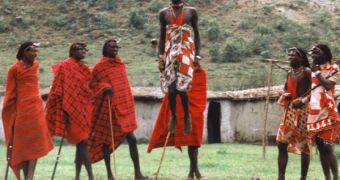Africa is a continent of the extremes. And the cradle of humankind. This is where the shortest people, the pygmies, appeared and still live.
Amongst those of pure blood, men have an average height of just 1.45 m (4.34 ft) and women of 1.33 m (4 ft)! But pygmies are not a dwarf variant of the Black Africans. Their heads look large compared to the rest of the body. But otherwise, they are perfectly proportioned (the dwarfs are deformed). They represent an ancient race and only the Khoi-San people (bushmen), now restricted to South Africa, are more ancient amongst current Homo sapiens races, who 50,000 years ago left Africa and reached New Guinea and Philippines, where nowadays pygmies still live.
But a biological law says that on tropics animals tend to have longer limbs than their counterparts living in areas with temperate/cold climate. Humans do not follow strictly biological rules, as they can shape their environment, but still, in Africa the tallest human race, with the longest limbs evolved.
This is the so-called Sudan type of the typical African Blacks. Today, this African race in its more or less pure form lives mainly in the southern Sudan and surrounding areas, while in central/western Africa they are heavily mixed with Congo type (the common typical Black Africans, like Bantu tribes).
In Ethiopia and Somalia, this race mixed intensively with a White one coming from southwestern Asia thousands of years ago.
In the case of some Sudanese tribes, males can have an average height of 1.9 m (6 ft, 4in) (!), while women of 1.8 m (6 ft) (!). These people have slim but strong bodies, and their heads are more elongated than in the case of the typical African Blacks. In case of a mixed race, these huge heights may not be generally attained by the population.
The most famous group and more racially preserved of the Sudanese race are the Nilotic tribes (they all originated on the Upper Nile area). The most famous are Maasai, Turkana, Samburu and Dinka, whose main occupation is animal husbandry.
Ancient (and modern) Nubians, the Black Pharaohs, were also of Sudanese race. When the French met this race of giants (in Chad tribes), they called them "the beautiful race".
The Surma tribe from southwestern Ethiopia is famous due to their women's habit of wearing lipplates.
On the marshes of the White Nile the Dinka live, tribes of nomad shepherds, whose main occupation is cattle/goat husbandry. That's why they are constantly in search of rich pastures.
Dinka people do not eat during daytime. In the evening, the family gathers around the fire to eat milk, fish, cooked water tubers, vegetables and rarely goat meat.
Cattle are never sacrificed. The community is led by a chief who chooses the grazing places. Each family detains a great number of cattle and some goats. Because they move so much, people do not keep too many belongings: just some clay pots, mats, headkerchiefs employed by the women to cover their heads and spear employed by men for hunting.
Children grow in groups and nobody is allowed to punish them. At the age of 6, boys start to accompany their father for learning husbandry and milking. For protection against the mosquito bites (that can spread malaria in these areas), Dinkas anoint their bodies with ash.

 14 DAY TRIAL //
14 DAY TRIAL //